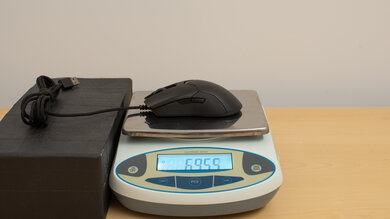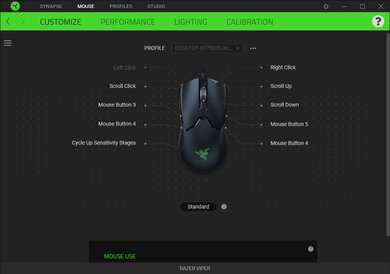The Razer Viper is a lightweight gaming mouse with an ambidextrous design. Thanks to its short and low-profile body, the mouse's shape is suitable for most hand sizes when using a fingertip grip, but people with small hands may struggle to reach the mouse clicks and scroll wheel. It has extremely low click latency, a wide and adjustable CPI range, and a very low lift-off distance. It's similar to the Razer Viper Ultimate, but the Viper is wired-only. Unfortunately, its cable isn't very flexible, and its customization software is available on Windows only.
Our Verdict
The Razer Viper is good for office use. While it doesn't have an ergonomic shape like some dedicated office mice, it should still feel very comfortable for most hand sizes using a claw or fingertip grip, but people with small or medium hands may also be comfortable with a palm grip. It feels very well-built and has many buttons you can reprogram to fit your needs; unfortunately, its customization software isn't available on macOS. Also, it isn't wireless, and some people might find the cable cumbersome.
- Comfortable, ambidextrous design.
- Four programmable side buttons.
- Wired-only design may be cumbersome.
- Software not compatible on macOS.
The Razer Viper is excellent for FPS gaming. It has extremely low click latency and feels responsive. It's surprisingly very light for a mouse without a honeycomb design and feels excellently well-built. Also, its body has a low profile that is great for a fingertip grip, but small hands may struggle to reach some buttons. It has a wide and adjustable CPI range, a high polling rate, and a low lift-off distance. However, the cable is a bit stiff and might create some drag.
- incredibly low click latency.
- Wide and adjustable CPI.
- Comfortable, ambidextrous design.
- Software not compatible on macOS.
The Razer Viper is very good for MMO gaming, but it doesn't have nearly as many side buttons as dedicated MMO mice. However, it has extremely low click latency, a wide and customizable CPI range, and a low lift-off distance. It feels excellently built and very comfortable, but people with larger hands may struggle with a palm grip.
- incredibly low click latency.
- Wide and adjustable CPI.
- Comfortable, ambidextrous design.
- Software not compatible on macOS.
The Razer Viper isn't designed for traveling. This wired mouse won't be ideal to use in tight spaces like a plane and isn't very portable.
- Very light.
- Wired-only design may be cumbersome.
- Software not compatible on macOS.
Changelog
- Updated Aug 16, 2023: We've added a link to the newly-reviewed Razer Cobra in the Shape section of this review.
- Updated Sep 16, 2022: We've converted this review to Test Bench 1.3. This update adds a new Sensor Latency test and makes minor changes to several of our existing tests, resulting in test result changes in several sections. For more information, you can check out our full changelog here.
- Updated Aug 15, 2022: We've converted this review to Test Bench 1.2. This update simplifies our Weight test and expands on our CPI test from Test Bench 1.1, resulting in changes to test results in both sections. For more details, you can see our complete changelog here.
- Updated Jun 22, 2022: We've updated this review to Test Bench 1.1, which revamped our click latency test methodology. We've updated the text to reflect our new results in various sections, including the Click Latency test box, Usages, Introduction, and other locations where we discuss click latency.
Check Price
Popular Mouse Comparisons
The Razer Viper is an excellent gaming mouse that sets itself apart by its design. While it doesn't have a honeycomb pattern to reduce its weight, it's almost as lightweight as some that do. It's also very similar to the Razer Viper Ultimate, but it can't be used wirelessly.
For other options, see our recommendations for the best gaming mice and the best wired mice, and if you'd prefer a wireless design, also check out the best wireless gaming mice.
The Razer Viper and the Razer DeathAdder V2 are very similar performing mice, and their main differences are shape and weight. The Viper has a lower profile body, while the V2 has a higher back hump. The Viper is also lighter than the V2 and has an ambidextrous design, while the V2 is slightly heavier and has a right-handed design.
The Razer Viper is overall a better mouse than the Razer Basilisk, but the Basilisk might be a better choice if you're right-handed and prefer using a palm grip. The Viper has an ambidextrous design that is noticeably lighter, and it has a lower click latency and a better cable. On the other hand, the Basilisk is suitable for all hand sizes when using a palm grip thanks to its ergo-shaped design with a thumb rest on its left side.
The Razer Viper Mini and the regular Razer Viper are both excellent wired gaming mice. The Mini is a bit lighter and smaller, making it better for fans of ultra-light mice or people with smaller hands. On the other hand, the sensor performance of the regular Viper is better, and it has a wider and more adjustable CPI range. The full-sized Viper also has two additional buttons on both sides, unlike just on the left side of the Mini.
The Razer Viper performs similarly to the GLORIOUS Model O and is almost just as light, even though it doesn't have a honeycomb pattern to reduce its weight. The Viper has two side buttons on each side, and its body is slightly smaller than the GLORIOUS. However, if you have small hands, the GLORIOUS is also available in a smaller size, called the GLORIOUS Model O-. Also, the GLORIOUS cable is noticeably lighter and more flexible than the Razer.
Test Results

The Razer Viper is a matte black mouse with an RGB-lit Razer logo on its back. It has the same ambidextrous design as the Razer Viper Ultimate, with two buttons on each side.
If you're interested in a wired gaming mouse that shares the same shape but has a scaled-down size that's better suited for medium and smaller-sized hands, check out the Razer Cobra.
Like most wired gaming mice, it isn't very portable. It might be harder to put in a laptop case or use in tighter areas like on a plane or in a bus. However, this shouldn't be an issue if you're looking for a gaming mouse to leave at home with your setup.
This mouse feels very well-built. It's similar to the Razer Viper Ultimate, but the feet don't feel as nice. Overall, it feels solid and durable, and there are no rattles or squeaky sounds. Although the L/R clicks wobble a little, it isn't very noticeable.
Despite not having a honeycomb design, this mouse is very light. It weighs slightly less than Razer Viper Ultimate, but it isn't quite as light as ultralight gaming mice like the Cooler Master MM710 or Finalmouse Ultralight 2 - Cape Town. If you like the Razer Viper and want something similar that's a bit lighter, check out the smaller Razer Viper Mini.
It has a true ambidextrous design with two buttons and nice textured grips on each side, so it should be comfortable for both left- and right-handed people. Because of its rather short and low-profile shape, the Razer Viper is suitable for a fingertip grip by any hand size. However, people with small or medium hands may also be comfortable with a claw or palm grip. If you prefer a mouse that has a right-handed ergonomic shape, check out the Logitech G403 HERO.
Due to its rather short and low-profile design, the mouse is suitable for small and medium hands when used with a palm grip. If you're interested in a similar mouse that's well-suited for a palm grip regardless of hand size, check out the BenQ ZOWIE FK1-B.
This mouse is wired-only. If you prefer a wireless design, check out the Razer Viper Ultimate.
Update 10/28/2021: After a previous retest, we incorrectly labeled that the cable did not have a permanent kink. However, while you're able to remove kinks from the cable, it's only temporary and they return to the same areas. For this reason, we've changed the Permanent Kink test result to 'Yes.'
The cable feels better than the older Razer cables but not as good as the recent ones on their Ultimate lineup. Our unit's paracord-like cable isn't very flexible, but it doesn't retain kinks from the packaging. For a similarly performing mouse with a better cable, check out the Endgame Gear XM1.
It uses optical switches for the main click buttons. Every button can be reprogrammed, including all four side buttons, the CPI switch on the underside of the mouse, and the up/down scrolls. You can also set a HyperShift button to give you a second layer of programmable inputs for as long as you hold the button. While you can reprogram the left click, you need to reassign the left click action to another button first.
The click latency of this mouse is incredibly low and consistent. It provides a very responsive-feeling experience for gaming in any genre.
The Razer Viper has a very wide CPI range that can be adjusted fairly precisely by increments of 50. The set CPI is consistent, but it tends to overshoot a bit more when you move slower than when you move fast; however, this shouldn't be noticeable to most people. It has a low lift-off distance, so the sensor shouldn't track your movements when you reposition your mouse. If you like the Razer Viper and want an even higher polling rate, check out the Razer Viper 8KHz.
The mouse clicks are quiet and shouldn't bother those around you when in a noise-sensitive environment.
It has limited customization with Razer Synapse 3. Although you can customize everything related to button-mapping, RGB lighting, and polling rate, the mouse doesn't have on-board memory, so you can't use this mouse on another computer with all your pre-saved settings. Unfortunately, the software isn't available on macOS. If you want a mouse with on-board memory and excellent software, check out the SteelSeries Sensei Ten.
While it's fully compatible with Windows, the software isn't available on macOS, so you can't remap the controls to anything other than their default settings. Also, the right side buttons don't work on macOS, so you can't use all four side buttons at once. If you want a mouse that has software that can be installed on macOS as well, check out the SteelSeries Rival 310, though it doesn't perform quite as well overall.
































